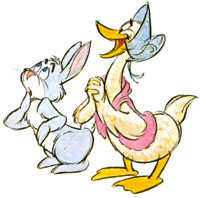| This book is dedicated to Hope and Ian, my wife and my son. |
 |
| - Preston Blair
|
|
| An American art form, animation is the process of drawing and photographing a character - a person, an animal, or an inanimate object - in successive positions to create lifelike movement. Animation is both art and craft; it is a process in which the cartoonist, illustrator, fine artist, screenwriter, musician, camera operator, and motion picture director combine their skills to create a new breed of artist - the animator.
|
| The art of animators is unique. Animators bring life to their drawings, creating an illusion of spirit and vigor. They caricature the gestures and expressions in the drawings, give them a fantastic array of character and personality, and make us believe that the drawings actually think and have feelings.
|
| This book was written by an animator to help you learn how to animate-how to make a series of drawings that create a sensation of movement when viewed in sequence. The pioneers of the art of animation learned many lessons, most through trial and error, and it is this body of knowledge that has established the fundamentals of animation. This book will teach you these fundamentals.
|
| Animators must first know how to draw; good drawing is the cornerstone of their success.
They must be able to dramatize and caricature life while they time and stage their characters' actions and reactions. The value of animators' work is determined by the ability of their characters to sway the emotions of the audience-in other words, the characters' "acting" skills. Animators must know how to entertain an audience: how to present gag comedy and how to portray an interesting or unusual happening of life. To do this, they study the great film comedians and read recognized texts on acting. This knowledge helps them to grip their viewers with suspense or make them smile and laugh with humor in the theater of animation.
|
| The animation process, however, involves much more than just good drawing. Animators must have knowledge of the elements of screen writing: plot-setting, premise, character, conflict, crisis, climax, exposition, dialogue, and action. These factors determine the types of personalities, expressions, and actions they will need to create. Moreover, if the animation includes a character moving her mouth in speech or song, animators need a knowledge of phonetics; if it features a character responding to a musical soundtrack, they must have a knowledge of music and rhythm. Animators must also know how an animation camera
works and how to time the character actions to fit the speed of the film. The list goes on and on; the animators'job is immeasurable.
|
| Animation is a vast and virtually unexplored art form. It is, perhaps, more popular today than ever before, and new techniques and methods of animating-including computer animation-are being developed all the time. There are many characters, styles, and background designs, however, that remain to be discovered-so pick up your pencil and get started!
|
| The curtains part as you turn the pages. The journey will be an exciting and adventurous one.
|
| Best wishes!
|
 |
|
 |
|
|


